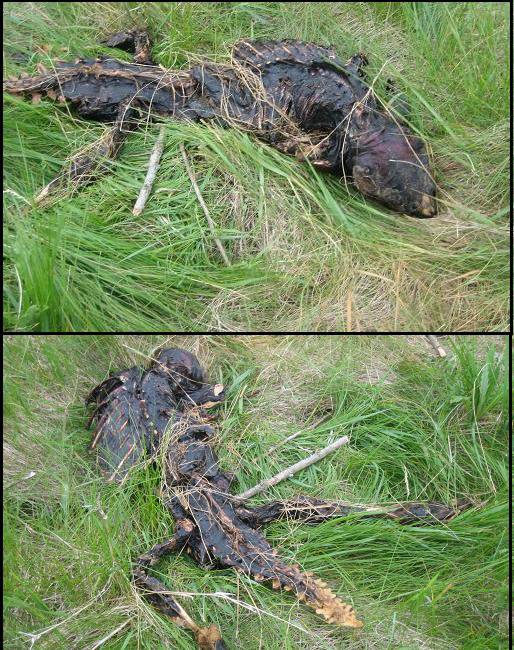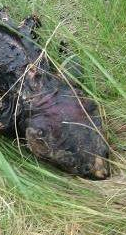What’s the Ajax Lorax?
Posted by: Loren Coleman on July 31st, 2012

A new unknown dead thing has turned up; this time in Ajax, Ontario, according to the person who found it.
I have to coin it as the Ajax Lorax, for, like Dr. Seuss’s critter, the Lorax, does this cryptid speak for the trees?
An internet posting of the photos were uploaded by SuperRobotBlank under the headline, “Found while walking the dog in Southern Ontario.”
Further questioning revealed that it was found in “a field next to my house for water overflow in the middle of standard suburbia. I would never have found it if my dog didn’t sniff it out. This was like 2 – 2.5 feet long… That’s definitely a good guess…”
What do you think the Ajax Lorax is?

{Thanks for newstip from C.S.}
About Loren Coleman
Loren Coleman is one of the world’s leading cryptozoologists, some say “the” leading living cryptozoologist. Certainly, he is acknowledged as the current living American researcher and writer who has most popularized cryptozoology in the late 20th and early 21st centuries.
Starting his fieldwork and investigations in 1960, after traveling and trekking extensively in pursuit of cryptozoological mysteries, Coleman began writing to share his experiences in 1969. An honorary member of Ivan T. Sanderson’s Society for the Investigation of the Unexplained in the 1970s, Coleman has been bestowed with similar honorary memberships of the North Idaho College Cryptozoology Club in 1983, and in subsequent years, that of the British Columbia Scientific Cryptozoology Club, CryptoSafari International, and other international organizations. He was also a Life Member and Benefactor of the International Society of Cryptozoology (now-defunct).
Loren Coleman’s daily blog, as a member of the Cryptomundo Team, served as an ongoing avenue of communication for the ever-growing body of cryptozoo news from 2005 through 2013. He returned as an infrequent contributor beginning Halloween week of 2015.
Coleman is the founder in 2003, and current director of the International Cryptozoology Museum in Portland, Maine.










Giant Japanese salamander?
I’m tempted to call this a decomposed hellbender, but to my knowledge that giant salamander does not really leave the water, and I’m not sure if it is even native to Ontario. It looks amphibious or reptilian to me, but that could just be due to the advanced state of decomposition it’s in.
agree with someone on the link a reptile or an amphibian for sure
Looks like a decaying beaver or something, every animal if left to decay will go through stages of looking odd, get a grip.
It certainly looks like a hellbender, but it could be a beaver or something else in thebadger/otter/weasel family. The head is the most deceptive looking part, with that triangle shape partly coming from having more flesh worn away or dessicated towards the nose, and those two hole that are too far away to be nostrils and too far forward to be eyes. Mammals, though, have a hole through the cheek for nerves, and that’s probably what those hole are.
I was also thinking something in the Mustelid family, perhaps a Marten. I think the aquatic appearance is more likely decomposition, as someone earlier said. Definitely interesting looking.
It’s a pity they didn’t open the mouth and take a picture of the teeth. That would solve the mystery pretty quick. Or heck, even the feet…
Looks like a skinned out beaver left to rot. The thickened vertebrae at the base of the tail agree with images I can find. As usual, pics contain little scale, no close ups of head or limbs, and the usual idiots are in calling it a “turtle out of it’s shell” which is physically impossible.
Scratch that-I just looked up what a hellbender skeleton looks like, and this is NOT it:
THAT is a hellbender skeleton. The skeleton here has hip bones that are too well developed, and the rib cage is also too developed. Not to mention the fact the head is the wrong shape-the skull of a hellbender is semicircular in shape, not triangular. So whatever it is, it is NOT a hellbender.
Poor scale, no closeups of the head or limbs. That said, it looks remarkably like a skinned out beaver left to rot.
Two and a half feet sounds too big to be a hellbender, assuming that estimate is accurate. Also, the rear limbs look too long and articulated to be those of a salamander.
Maybe a fisher or a wolverine?
This was pretty intriguing for awhile, but in reading the Reddit comments, I saw a suggestion that it was a shell-less snapping turtle. That would put this find in the northern part of its range, and would make sense with the potential aquatic environment source. It also makes sense to me why the appendages seemed so unnaturally long, particularly relative to the apparent bulk posterior to the pelvic girdle.
It also fits the vertebral appendages/spurs whatever those are called in snapping turtles. The only thing that still doesn’t add up for me is the neck length (seems too short – but the details may be obscured by the decomposition/dessication and remnants of the skin.
Here’s a dorsal view of a turtle skeleton, for reference:
It’s looks to be a decomposed black and white tegu or even a possible alligator
I bet it’s just someone’s pet tegu or savannah monitor. A scale reference would have helped.
Escaped Gila monster pet?
I say Beaver. Google Beaver skeleton, the tail nails it.
For the last time, there is no such object as a “shell-less turtle”. The carapace (shell) is formed from the spine, and the plastron (bottom shell) is formed from the ribs.
100% snapping turtle sans shell
looks like a large salamander or hellbender
+1 for Tegu
Looks a lot like a decomposed North American Badger, especially around the head area which bears a resemblance with its rectangular bulgy shape and pudgy ears.
I’m definitely leaning towards beaver, but the ribcage is the wrong shape but that might just be obscured by decomposition
The head definitely says beaver to me
This case is not that easy to solve, as there is not much anatomical data (i.e. bones) really visible. At first, NO, it is not a turtle without shell!
People, stop thinking turtles can lose their shell! Their shell consists of their ribs, so they can´t get lost like skin. The rest of the anatomy doesn’t fit a turtle anyway.
Actually there is a quite simple and – as I think – rational explanation. Given the size, shape, locality and especially a particular anatomical detail, this is next to sure a beaver.
At first please take a look at the proportions of a beaver skeletons (note the long hind legs in particular):
The shape of a beaver skeletons is very similar to those of this carcass, but there is an anatomical trait which is typical for beavers, very wide transveral spines on the caudal vertebrae:
The overall shape of the head is also well fitting those of a beaver:
Of course there are still muscles attached to the skull of the carcass, so the head looks still more massive.
You don’t find such spinal processes in raccoons, fishers or the other supposed mammals like otters.
Did anyone suggest a shell-less turtle?
Just kidding, those are good points about the turtle – I’ve seen many shell-less, but they were also less many other things, having had them removed via highway traffic.
Another thing I was thinking of – since on last season’s Game of Thrones there were still three viable dragon eggs after all those years, maybe there were more? And this one didn’t make it? Any reports of fire in the area?
The carcass has obviously long ribs, whereas turtles have no long ribs. Physical damage can only remove parts of a turtle´s shell, if the whole shell would be really removed, there would be nothing left but a tiny dorsal spine.